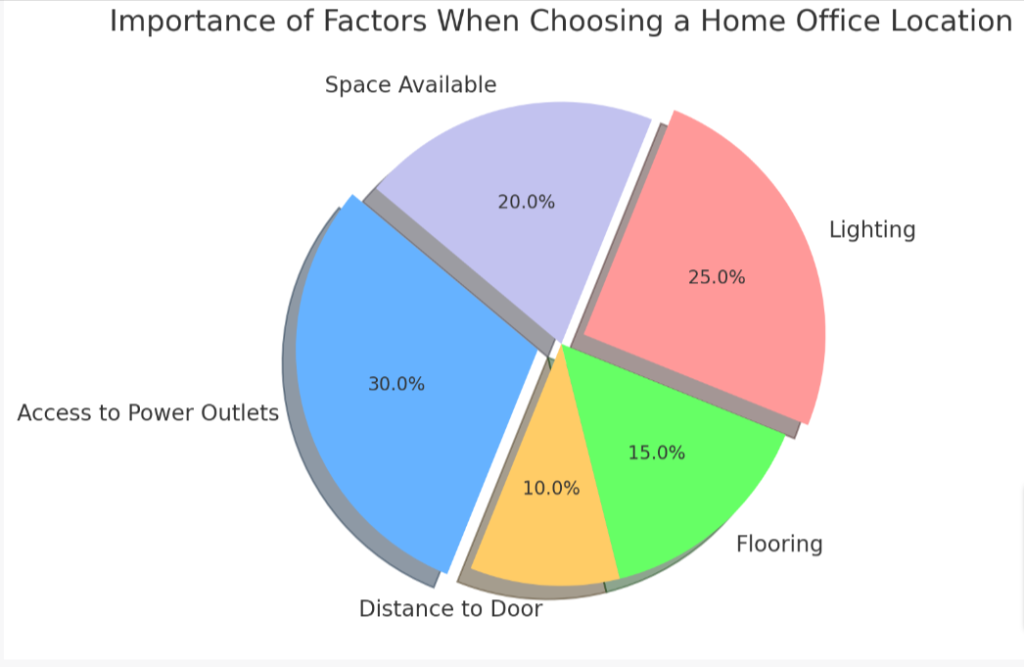Corner Office vs. Kitchen Table: Evaluating Workspace Options
Looking to create a home office but torn between the kitchen table or that quiet corner? This is a common dilemma for many transitioning into remote work. Surprisingly, your choice could significantly impact productivity and job satisfaction.
Let’s delve into factors like room size, furniture arrangement and even Feng Shui principles that will guide you in making the best decision for your workspace situation. Ready to get started?.
Key Takeaways
- Access to power outlets is crucial for a home office, so ensure there are enough nearby for all your electronic devices.
- Placing your home office close to an entrance provides easy access to deliveries and quick breaks outside.
- Choose flooring that suits the nature of your work, whether it’s hardwood floors for a formal look or laminate/vinyl for easy cleaning.
- Good lighting is essential for reducing eye strain, so position your desk near a window and use task lighting when natural light is limited.
- Consider the amount of space available in the room and make sure there’s enough room to move around comfortably.
- When arranging furniture in different rooms, consider factors like power outlet accessibility, minimizing distractions, and maximizing storage options.
- Vastu tips can help create an ideal placement for your desk, choose color schemes that promote productivity and creativity, incorporate natural elements like plants and wood into your workspace.
Factors to Consider Before Choosing a Home Office Location
Consider access to power outlets, ensuring that there are enough nearby for all your electronic devices and equipment.
Access to power outlets
Power outlets govern the location of many essential items in your home office. Task lighting, computers, and chargers for various devices all need easy access to electricity. You don’t want extension cords snaking across your floor creating a trip hazard and an untidy look.
If possible, place your desk closer to multiple power outlets or consider installing more if you find the current number insufficient. The aim is not merely comfort but safety and efficiency in your work environment as well.
Distance to door
Placing your home office close to an entrance can serve multiple purposes. You’ll have easy access to deliveries, which is especially handy if you frequently receive work-related packages.
A door nearby gives the added benefit of making quick trips outside a breeze, when breaks are needed for fresh air or stretching exercises after long periods of sitting.
Despite these advantages, there are also some potential drawbacks. Noise from the outside can be distracting and disrupt concentration during important tasks or teleconferences. To maintain a balance between accessibility and peace, consider installing soundproof materials on doors and walls adjacent to your workspace.
This simple step ensures that you keep external noise at bay while still enjoying the benefits of having your home office near an entrance.
Flooring
Choosing the right flooring for your home office can significantly impact your comfort and productivity. Hardwood floors, for instance, offer a formal and elegant look that’s ideal for those who entertain clients or conduct professional meetings at home.
Carpeting creates a warm and cozy environment, perfect if you spend long hours on your feet. On the other hand, laminate or vinyl flooring is easy to clean which makes it suitable for workspaces prone to spills such as art studios or crafting areas.
It’s essential to align your flooring choice with the nature of your work and personal preference.

Lighting
A well-lit home office can make a big difference in your productivity and overall work experience. Good lighting is essential for reducing eye strain and fatigue, as well as creating a comfortable and inviting workspace.
When choosing the right lighting for your home office, opt for natural light whenever possible by positioning your desk near a window. If natural light is limited, supplement it with task lighting such as a desk lamp or floor lamp to ensure that you have adequate illumination for reading documents or typing on your computer.
Avoid harsh overhead lighting that can cause glare on screens or create uneven shadows. Instead, use adjustable lighting options that allow you to control the brightness and direction of the light according to your needs.
To further enhance the quality of light in your home office, consider using warm-colored bulbs instead of cool white ones. Warm-colored bulbs emit a softer and more soothing light that can help reduce eye strain throughout the day.
Space available
Consider the amount of space available when choosing a location for your home office. Look at the size of the room and determine if it can accommodate all your necessary furniture and equipment comfortably.
Make sure there is enough room to move around without feeling cramped. Consider how much storage space you will need for files, supplies, and other items. A well-organized and spacious home office can contribute to better productivity and focus on your work tasks.
Tips for Arranging Furniture in Different Rooms
Arrange furniture in the living room to create a cozy and inviting space for relaxation and entertainment.
Living Room
The living room is a common choice for setting up a home office. It offers convenience and easy access to the rest of the house. When arranging furniture in the living room, keep these tips in mind:
- Position your desk near a power outlet for easy access to electricity.
- Place your desk near the door to minimize disruptions and distractions.
- Ensure that the flooring is comfortable and suitable for an office environment.
- Arrange lighting sources strategically to eliminate glare and provide sufficient brightness.
- Make use of available space efficiently by considering storage options and organization solutions.
Bedroom
For those considering setting up a home office in their bedroom, here are some tips for arranging furniture:
- Measure the space: Take accurate measurements of your bedroom to determine how much furniture and equipment can fit comfortably.
- Choose the right desk: Select a desk that fits the size of your room and complements its overall design. Consider factors like storage options and ergonomics.
- Optimize storage: Look for furniture pieces with built-in storage to maximize space efficiency. This could include desks with drawers or shelves.
- Consider natural light: Position your desk near a window if possible, as natural light can boost productivity and create a pleasant working environment.
- Create boundaries: Use room dividers or curtains to separate your workspace from the rest of the bedroom, helping to maintain focus and minimize distractions.
- Minimize clutter: Keep your work area organized by utilizing organizers and storage solutions to keep essential items within reach without overcrowding the space.
Dining Room
The dining room can be an ideal location for a home office. Here are some tips for arranging furniture in your dining room to create a functional workspace:
- Measure the space: Before you start arranging furniture, measure the dimensions of your dining room to ensure that your desk and other essential items will fit comfortably.
- Choose the right desk: Select a desk that fits well in the space and complements the existing decor of your dining room. Consider factors such as size, style, and storage options.
- Position your desk: Place your desk against a wall or in a corner of the dining room to maximize space and minimize distractions. Make sure it is positioned near power outlets for easy access to electricity.
- Utilize storage solutions: Use shelves, cabinets, or a credenza to store office supplies and keep them organized. This will help maintain a clutter-free workspace in your dining room.
- Comfortable seating: If you have enough space, consider adding a comfortable chair or two beside your desk to provide additional seating options when needed.
- Lighting considerations: Ensure there is adequate lighting in your dining room home office setup. Consider using a combination of natural light from windows or skylights, as well as task lighting such as desk lamps or overhead lights.
Vastu Tips for Setting Up a Home Office
When setting up a home office, it is important to consider Vastu tips for an ideal placement of the desk, selecting color schemes, incorporating natural elements, and paying attention to the location and direction of the workspace.
Importance of location and direction
The location and direction of your home office play a crucial role in creating a productive workspace. The right location can help you avoid distractions and promote focus, while the proper orientation can enhance positive energy flow.
By considering factors such as natural lighting, noise levels, and accessibility to power outlets, you can optimize your productivity and create an environment that supports your work-from-home routine.
Take into account Vastu tips or Feng Shui principles for setting up your desk in an ideal position, choose color schemes that inspire creativity, and incorporate natural elements to bring balance to your workspace.
Ideal placement of desk
Positioning your desk in an ideal location is essential for creating a productive home office. Look for a spot that offers good natural light and avoids glare on your computer screen.
Place the desk near a window, if possible, to benefit from the view and natural light. Additionally, consider the flow of traffic in the room and position your desk away from distractions like doors or high-traffic areas.
A well-placed desk can make all the difference in creating a functional and efficient workspace.
Color schemes
Choose a color scheme for your home office that promotes productivity and creativity. Consider using shades of blue, which are known to increase focus and concentration. Alternatively, opt for a calming green or energizing yellow to create a positive and inspiring atmosphere.
Avoid overly bright or distracting colors that may hinder your ability to work effectively. Experiment with different combinations until you find the color scheme that best suits your needs and enhances your productivity in the home office setting.
Use of natural elements
Incorporating natural elements into your home office can create a calming and productive atmosphere. Adding plants to your workspace not only improves air quality, but also brings a touch of nature indoors.
Additionally, using natural materials such as wood or bamboo for furniture and accessories adds warmth and texture to the room. Natural light is also important for creating an inviting space, so consider positioning your desk near a window or investing in daylight bulbs.
By embracing natural elements, you can enhance both the aesthetics and functionality of your home office.
Conclusion
In conclusion, when choosing the right location for your home office, there are a few factors to consider. You should think about access to power outlets, distance to the door, lighting, and the space available.
Additionally, arranging furniture in different rooms can help create a functional workspace. And don’t forget about Vastu tips for setting up your home office – they can make a difference in productivity and overall atmosphere.
Take these factors into account to design a comfortable and efficient home office that suits your needs.

